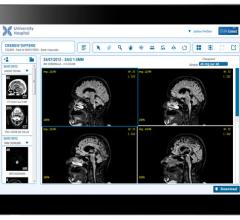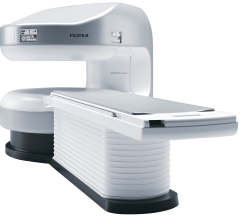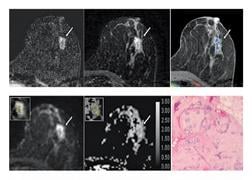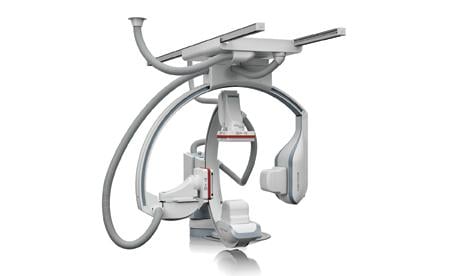GE Healthcare has received 510(k) clearance and CE marking of its magnetic resonance (MR) solution for head and neck imaging in the presence of radiation therapy (RT) immobilization devices.
According to a new survey by Etiam, hospitals see a significant need for an organized system to manage the sizable flow of medical images many receive from beyond the enterprise. Hospitals also expressed concern about the security of the cloud, which increasingly plays a role in cross-enterprise access to this patient data.
Fovia Medical Inc., and Softneta UAB are collaborating to deliver High Definition Volume Rendering to the telemedicine market.
Fujifilm’s APERTO Lucent is a 0.4T mid-field, open MRI system addressing today’s capability and image quality needs ...
Two-dimensional plus 3-D breast imaging increases cancer detection rates by 11 percent, and could be particularly useful in detecting cancer in women with dense breasts, a new study suggests.
In the 1970s when I studied at the University of Wisconsin-Madison, the UW had a reputation for being a hotbed of insurrection. I did my part in 1975 by wearing Gerald Ford’s WIN button upside down. It was a tacit repudiation of the idea that a public relations campaign could spawn a grassroots movement to “Whip Inflation Now” and an implied statement that there are “No Immediate Miracles.”

SPONSORED CONTENT — Fujifilm’s latest CT technology brings exceptional image quality to a compact and user- and patient ...
Magnetic resonance imaging (MRI) has emerged as a valuable imaging modality for breast cancer detection and staging. Dynamic contrast-enhanced MRI (DCE-MRI) is the most sensitive technique for screening high-risk women and for evaluating the extent of disease in patients with a recent diagnosis of breast cancer.[1,2] Despite its numerous advantages, the moderate specificity of DCE-MRI can result in a substantial number of false positive findings that translate to high recall rates and unnecessary biopsies.
SPONSORED CONTENT — Fujifilm’s latest CT technology brings exceptional image quality to a compact and user- and patient ...
Multiple industries have undergone a complete metamorphosis as a result of advancing electronics, and the medical world is no exception. Perhaps a little late to recognize the technological transformation, the healthcare industry is finally catching on to the latest trends and incorporating the newest devices into everyday use. One device, in particular, is going to revolutionize medicine forever.
Treatment of early stage breast cancer continues to evolve as researchers investigate more novel and efficient methods of radiotherapy. Clinical trials on accelerated partial breast irradiation (APBI) are showing that these newer methods can offer carefully selected patients several advantages over traditional whole breast irradiation (WBI).
In the small rural town of Kingman, AZ — approximately 90 minutes southeast of Las Vegas — most of its 28,000-plus population are economically disadvantaged; some of them still work in local gold and silver mines. So for women living in the area, getting a mammogram every year isn’t a priority; in fact, notes Dr. Christopher Johansen, Kingman Regional Medical Center (KRMC) Radiologist and Director of its Breast Imaging Program, “Many of our residents don’t have health insurance. And many aren’t even aware of the importance of getting annual mammograms.”
SPONSORED CONTENT — EnsightTM 2.0 is the newest version of Enlitic’s data standardization software framework. Ensight is ...
There were three key trends in X-ray vascular imaging systems made evident from new products showcased at the Radiological Society of North America (RSNA) annual meeting in late 2012. These include new hardware and software to lower ionizing radiation doses and improve image quality, better dose tracking software, and enhanced maneuverability for improved patient access and use in the growing hybrid OR market. As interventional procedures become more complex, imaging times have increased, raising concerns that are now being addressed by vendors.
Lancaster General Health is a 550-bed system in Central Pennsylvania performing nearly 500,000 exams per year in its major acute-care hospital, rehabilitation hospital, women’s center and 12 outpatient facilities. The 28 diagnostic radiologists and three radiation oncologists at Lancaster Radiology Associates, Ltd. handle all the radiology services for the health system, providing around-the-clock coverage using the McKesson Radiology picture archiving communications system (PACS). Leigh S. Shuman, M.D., a practicing radiologist at Lancaster Radiology Associates and the PACS medical director for the health system, recently spoke to us about the rollout of a workflow solution, the McKesson Qualitative Intelligence and Communications System (QICS) by peerVue.
Imaging children has challenges that relate to the size, maturity and anxiety of the patient. In addition, we have become increasingly aware of the risks associated with radiation exposure, an issue that is of paramount importance to young patients. Through the efforts of professional organizations, industry and the Image Gently campaign, launched in 2008 by The Alliance for Radiation Safety in Pediatric Imaging, tremendous advancements have been made in technology and its use to help meet these challenges.
Did you know that approximately one-third of all the data in world is created by the healthcare industry and that ...
New computed tomography (CT) dose studies and growing public media attention have made minimizing unnecessary radiation dose to patients a priority for medical imaging facilities. In addition, state regulatory agencies and accrediting bodies are increasing their oversight and regulation of radiation dose. Reducing dose while maintaining good clinical image quality, however, is complex.
The American Society for Radiation Oncology (ASTRO) has issued a new white paper, “Assuring Safety and Quality in Image Guided Delivery of Radiation Therapy,” that recommends best practices to improve the safety and effectiveness of image guided radiation therapy (IGRT), according to the manuscript published as an article in the online journal Practical Radiation Oncology (PRO).
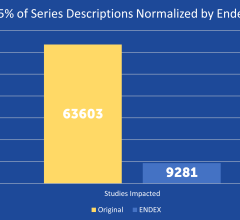
SPONSORED CONTENT — EnsightTM 2.0 is the newest version of Enlitic’s data standardization software framework. Ensight is ...
At the International Society for Magnetic Resonance in Medicine’s (ISMRM) 21st Annual Meeting in Salt Lake City, Utah, Philips Healthcare demonstrated a range of clinical functionalities in magnetic resonance imaging (MRI).
Leading research institutions are making breakthroughs in advanced magnetic resonance (MR) imaging with Toshiba America Medical Systems Inc.’s Vantage Titan 3.0T MR system. Toshiba has partnered with Shands at the University of Florida and the Keck Medical Center of the University of Southern California (USC) for MR research in fMRI, as well as body and cardiac imaging.
April 24, 2013 — A prostate cancer patient has become the first person in the world to be treated using the latest version of Varian's Vitesse real-time planning solution for planning and performing advanced high-dose-rate (HDR), ultrasound-guided brachytherapy treatments. The treatment took place at the Levine Cancer Institute in Charlotte, N.C.
More than three years after the United States Preventive Services Task Force (USPSTF) recommended against routine mammogram screening for women between the ages of 40 and 49, a study from Brigham and Women's Hospital (BWH) finds that mammogram rates in the United States have not declined in that age group, or any other. The study results are published in the online journal Cancer.
Varian Medical Systems and Paul Scherrer Institute (PSI) announced a collaboration to further advance motion management techniques for proton therapy. The multi-year agreement, aimed at optimizing treatment strategies for indications such as cancer in the lung, liver, pancreas and breast, will evaluate strategies using a 4-D treatment planning simulator developed by PSI.
Nucletron, an Elekta company, has introduced its redesigned Flexitron remote afterloading platform. Flexitron emphasizes safety and efficiency in the brachytherapy workflow, increasing the clinician's confidence that execution of all workflow steps will proceed as planned for brachytherapy/treatment delivery.


 April 26, 2013
April 26, 2013 
